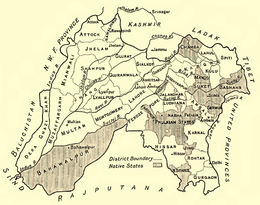Nabha State
Nabha State,[1] with its capital at Nabha, was one of the Phulkian princely states of Punjab during the British Raj in India.[2]
| Nabha State | |||||||||
|---|---|---|---|---|---|---|---|---|---|
| Princely State | |||||||||
| 1763–1947 | |||||||||
 Coat of arms
| |||||||||
 Nabha State in a 1911 map of Punjab | |||||||||
| Area | |||||||||
• 1901 | 2,502 km2 (966 sq mi) | ||||||||
| Population | |||||||||
• 1901 | 297,949 | ||||||||
| Historical era | New Imperialism | ||||||||
• Established | 1763 | ||||||||
• Accession to India | 1947 | ||||||||
| |||||||||
| Today part of | India | ||||||||
_(14597378638).jpg)
Sir Hira Singh, Raja of Nabha (c.1843-1911).
Demography
According to the 1901 census the state had a population of 297,949 and contained four towns and 488 villages. Its population at the previous two enumerations were: 282,756 (1891) and 261,824(1881).
Nabha was divided into three nizamats: Amloh and Bawal, with their headquarters at the town from which each is named; and Phul, with its headquarters at Dhanaula.[3]
More than 54 per cent of the population were Hindus, only 26 per cent being Sikhs — although Nabha was one of the principle Sikh states of the Punjab, the remainder of the population were Muslim.[4]
References
- Imperial Gazetteer of India, v. 18, p. 271.
- Chisholm, Hugh, ed. (1911). . Encyclopædia Britannica. 19 (11th ed.). Cambridge University Press. p. 147.
- Nābha State - Imperial Gazetteer of India, v. 18, p. 264.
- Nābha State - Imperial Gazetteer of India, v. 18, p. 265.
External links

This article is issued from Wikipedia. The text is licensed under Creative Commons - Attribution - Sharealike. Additional terms may apply for the media files.